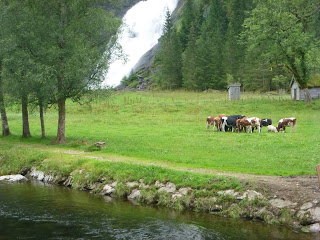Trout for tea...
Neither of us particularly like trout, which is very strange considering that fly fishing is my favourite pastime. However, as I mentioned in an earlier post, one of the reasons for visiting Norway was to have some time fishing in the pristine waters that are to be found everywhere. Well nearly everywhere. At one of the places that I tried today farm waste and raw farm sewage was dumped next to the river in a rotting pile. It seems that farmers in NZ and Norway share a common bond when it comes to polluting rivers or streams.
In the morning we made a short drive of about 65km from the town of Forde to the unpronounceable village at Byrkjelo passing the usual spectacular scenery on the way, such as the "Haldefosset" falls where we stopped nearby and walked up to.
This was definitely the best waterfall so far. Very unusual to see sheep and cattle so close together too.
We drove through our destination of Byrkjelo before we even realised, (you can walk the length of the village in 5 minutes), and because of the narrow main road we had to drive some way before we could find a turning place. We decided that a bus lay-by would do for our manoeuvrings and pulled in just in front of the bus shelter. We then noticed a Police car parked just behind the shelter, then two sheepish looking policemen popped out of the shelter where they had been hiding, whilst pointing a radar camera-gun through a tiny window in the side of the shelter.
We quickly realised that we were blocking their radar shots so gave them a quick smile and wave and drove on. It was about 2 km before we found a suitable spot to turn and reverse our steps, by which time the Plod had flagged down some poor sod for speeding. The moral of the story is to beware strange men hanging around in bus shelters!
The campsite at Byrkjelo is situated in a lovely spot and once the rain had cleared we had a great view back up the valley where the peak called Snonipa could be seen, (the one that looks a bit like Mitre peak in Milford).
Before the clouds had lifted.
And after, with Snonipa in view.
After settling in the campsite, including Iris' customary and immediate sewage disposal inspection, which passed muster, we followed with lunch, then we took a drive up the (unnamed) river that ran through the valley whilst looking for fishing spots. The weather had turned very cold with a biting wind but we were not to be deterred and a couple of likely looking pools were identified as prime fishing spots. Iris took some sneaky photos of me fishing in the turquoise stream and then retreated to the comfort of the motorhome while I froze.
Afficianados will note that I'm spin-fishing, not fly-fishing, mainly because the river was too deep and swift to wade, plus a gale was blowing into my face that would have made fly casting very difficult. I'd bought a pack of 5 spinning lures of assorted colours at the local Co-op shop at a very reasonable price, (cheaper than the UK) and Iris was given the choice of which lure I should use. She selected one that she dubbed the "Norwegian Blue" because of its colour.
Anyway, the end result was the first respectably sized Norwegian trout that I have caught, or in other words tea.....
I very rarely kill the fish that I catch but given the price of food in Norway, plus the advice from Iris' friend Penny about foraging for food in these climes, the trout was swiftly despatched and prepared for the pot.
I still had time to try a couple of other likely looking spots such as the one below, with no results other than a couple of minnows.
This little chap was released to grow into someone's tea. The lure that I was using was almost the same size as the fish, so it obviously didn't have an inferiority complex.
Hot trout with salad for tea.






















































